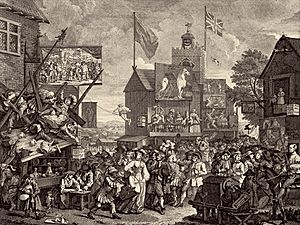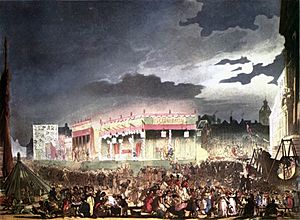Charter fair facts for kids
A charter fair in England is like a special street market or festival that was given official permission by the King or Queen. This permission was called a Royal Charter. Many of these fairs started a very long time ago, during the Middle Ages, and were most popular in the 1200s.
At first, most charter fairs were places where people bought and sold things. But since the 1800s, they have become more about fun and entertainment. Today, many charter fairs are home to exciting travelling funfairs, run by people called showmen.
Contents
Where Did Fairs Come From?
Long, long ago, even in Roman times, fairs were like holidays. People would stop working and enjoy themselves. By the 600s, a regular fair was held in Saint-Denis, France.
Later, all over Europe, special Christian religious events, like the day a church was dedicated, would bring people together. Tradesmen would come to sell their goods, sometimes even in the churchyard. These fairs then happened every year, usually on the feast day of the patron saint the church was named after.
In England, these early fairs were called "wakes" or vigilias. Many of them later became the basis for the bigger, official chartered fairs. Back then, it was hard and often dangerous to travel and communicate. So, local markets and fairs were super important for buying, selling, and trading goods.
How Chartered Fairs Grew in England

In England, fairs really started to grow after the Normans arrived. They became most popular in the 1200s. During the 1100s, many English towns got permission from the King to hold an annual fair. These fairs usually served local people and lasted for a few days.
By the end of the 1100s, trade with Europe was increasing, especially for wool and cloth. Merchants in London tried to control this trade. But many English producers and ports on the east coast used the new chartered fair system to sell their goods directly.
At the same time, rich customers in England started using these new fairs. They could buy things like spices, wax, preserved fish, and cloth in large amounts directly from international merchants. This also helped them avoid the usual London merchants.
Local nobles and church leaders could earn a lot of money by hosting these events. The King also benefited from payments for giving out the original charters. Between 1200 and 1270, English kings issued over 2,200 charters for markets and fairs.
Markets vs. Fairs: What's the Difference?
Between the 1100s and 1400s, the number of markets and fairs across England exploded. Even though "fair" and "market" were often used to mean the same thing, they had key differences.
Markets were held daily in bigger towns or weekly in the countryside. They sold fresh food and everyday items. Fairs, however, happened only at certain times, usually linked to a religious festival. Fairs were for more valuable goods and things that didn't spoil, like farm tools, furniture, rugs, and pottery.
Even though trading was the main goal of a fair, they usually had some entertainment too. This could include dancing, music, or even tournaments. By 1516, England had about 2,464 markets and 2,767 fairs. Wales had 138 markets and 166 fairs. Both fairs and markets were important places for social life in medieval times.
Famous Medieval Fairs
Towns like Boston, Winchester, Stamford, and St Ives got royal charters to hold huge, long events. These focused on international trade. By the mid-1200s, the main fairs followed a set schedule:
- Stamford fair in Lent (early spring)
- St Ives at Easter
- Boston in July
- Winchester in September
- Northampton in November
Other important chartered fairs, like those at Stourbridge, Bury St Edmunds, King's Lynn, Oxford, and Westminster, filled the gaps. The Stourbridge fair eventually became the biggest fair in Europe by the end of the medieval period. Many of these fairs were smaller than the largest European international fairs. Still, they involved big international deals and advance selling.
These "great fairs" could be massive events. St Ives' Great Fair, for example, attracted merchants from Flanders, Brabant, Norway, Germany, and France. It lasted four weeks each year, turning the small town into a "major commercial center." Dozens of stalls would be set up, and hundreds of pounds of goods were bought and sold.
Special courts, called courts of piepowders, were set up to manage these events and settle arguments. They would establish local laws, set up systems for weights and measures, and check legal contracts.
Why Fairs Became Less Important

Towards the end of the medieval period, fairs started to decline. One big change was that major merchants, especially in London, became more powerful by the 1300s. Instead of rich customers buying from a chartered fair, they would buy directly from the merchant.
For example, the records of Henry III show that he bought 75% of what he needed from the great fairs. But by the time of Edward II, most things were bought directly from major merchants.
The rise of international trading groups like the Hanseatic league in the 1400s also played a part. Better communication and the growth of a larger English merchant class in big cities, especially London, slowly made chartered fairs less valuable. Foreign merchants, who the great fairs had relied on, were being replaced by English merchants, especially in important areas like the cloth trade.
The King's control over trade in towns, especially newer towns without strong local governments, became weaker. This made chartered status less important as more trade happened in private shops all year round.
However, the great fairs were still important well into the 1400s. They were used for exchanging money, regional trade, and giving people more choices when buying things. Finally, the development of canals and then the railway system in England during the 1800s almost made the fair system disappear. But in recent years, many have been brought back as cultural events, rather than mainly for trade.
See also
- Artisanal food
- Bazaar
- Carnival
- Charter
- Charter Stones
- Costermonger
- Dudsday traditional Scottish festival day
- Festival
- Hawker
- History of marketing
- Kermesse (festival) - A Dutch festival or fair
- List of Renaissance fairs
- Market town
- Marketing
- Market (place)
- Market hall
- Merchant
- Parish festival
- Peddler
- Retail
- Souk or souq
- Street vendor
- Town privileges
- Whitsun - traditional English day of fairs/festivals
Some Chartered Fairs in the United Kingdom
- Appleby Horse Fair
- Baldock Charter Fair
- Bampton Fair, Devon
- Barnet Fair also see Barnet Market
- Bartholomew Fair, London
- Beaconsfield, Buckinghamshire
- Beverley town fair, Yorkshire
- Banagher Horse Fair, Ireland
- Brigg Horse fair, North Lincolnshire
- Glasgow Fair
- Godiva Festival - formerly Trinity Great Fair, Coventry
- Haslemere Charter Fair, Surrey
- Hull Fair (travelling fair)
- St Lawrence Fair, Hurstpierpoint, West, Sussex
- Ickleton Priory Annual Fair, Cambridgeshire
- Ilkeston Charter Fair, Derbyshire
- Lenton Fair, Nottinghamshire
- Loughborough#Loughborough Charter Fair, Loughborough, Leicestershire
- Midsummer Common -location of Midsummer Fair, Cambridge
- Nottingham Goose Fair, Nottinghamshire
- Petersfield Fair, Hampshire
- Petworth Fair, Sussex
- Rothwell Fair
- St James Fair, Bristol
- Scarborough Fair (fair)
- Stamford Mid Lent Fair
- Stourbridge fair
- Stow Fair, Lincolnshire
- Summercourt fair
- Tewkesbury Mop Fair
- Thrapston Charter Fair, Northamptonshire
- Wickham Horse Fair


